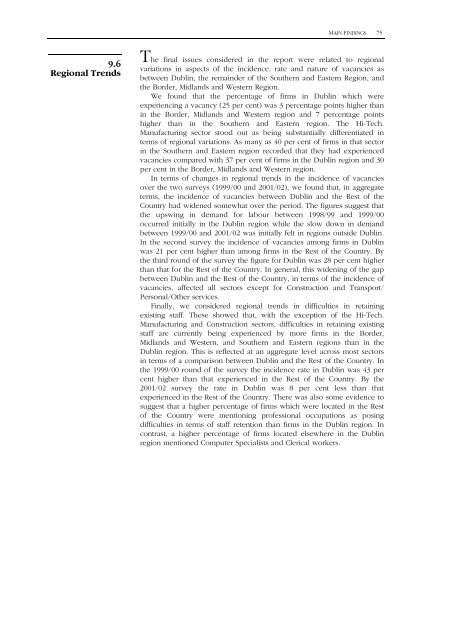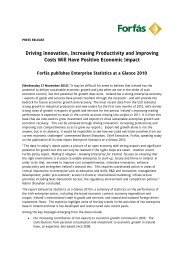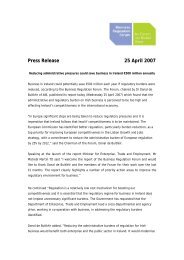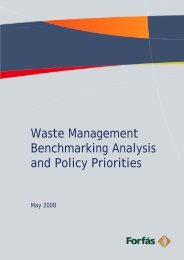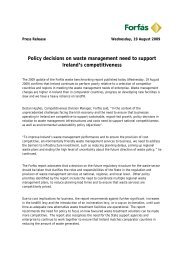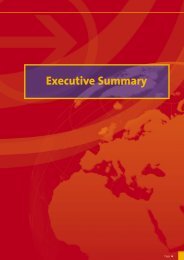National Survey of Vacancies in the Private (Non ... - Forfás
National Survey of Vacancies in the Private (Non ... - Forfás
National Survey of Vacancies in the Private (Non ... - Forfás
You also want an ePaper? Increase the reach of your titles
YUMPU automatically turns print PDFs into web optimized ePapers that Google loves.
9.6<br />
Regional Trends<br />
MAIN FINDINGS 75<br />
The f<strong>in</strong>al issues considered <strong>in</strong> <strong>the</strong> report were related to regional<br />
variations <strong>in</strong> aspects <strong>of</strong> <strong>the</strong> <strong>in</strong>cidence, rate and nature <strong>of</strong> vacancies as<br />
between Dubl<strong>in</strong>, <strong>the</strong> rema<strong>in</strong>der <strong>of</strong> <strong>the</strong> Sou<strong>the</strong>rn and Eastern Region, and<br />
<strong>the</strong> Border, Midlands and Western Region.<br />
We found that <strong>the</strong> percentage <strong>of</strong> firms <strong>in</strong> Dubl<strong>in</strong> which were<br />
experienc<strong>in</strong>g a vacancy (25 per cent) was 3 percentage po<strong>in</strong>ts higher than<br />
<strong>in</strong> <strong>the</strong> Border, Midlands and Western region and 7 percentage po<strong>in</strong>ts<br />
higher than <strong>in</strong> <strong>the</strong> Sou<strong>the</strong>rn and Eastern region. The Hi-Tech.<br />
Manufactur<strong>in</strong>g sector stood out as be<strong>in</strong>g substantially differentiated <strong>in</strong><br />
terms <strong>of</strong> regional variations. As many as 40 per cent <strong>of</strong> firms <strong>in</strong> that sector<br />
<strong>in</strong> <strong>the</strong> Sou<strong>the</strong>rn and Eastern region recorded that <strong>the</strong>y had experienced<br />
vacancies compared with 37 per cent <strong>of</strong> firms <strong>in</strong> <strong>the</strong> Dubl<strong>in</strong> region and 30<br />
per cent <strong>in</strong> <strong>the</strong> Border, Midlands and Western region.<br />
In terms <strong>of</strong> changes <strong>in</strong> regional trends <strong>in</strong> <strong>the</strong> <strong>in</strong>cidence <strong>of</strong> vacancies<br />
over <strong>the</strong> two surveys (1999/00 and 2001/02), we found that, <strong>in</strong> aggregate<br />
terms, <strong>the</strong> <strong>in</strong>cidence <strong>of</strong> vacancies between Dubl<strong>in</strong> and <strong>the</strong> Rest <strong>of</strong> <strong>the</strong><br />
Country had widened somewhat over <strong>the</strong> period. The figures suggest that<br />
<strong>the</strong> upsw<strong>in</strong>g <strong>in</strong> demand for labour between 1998/99 and 1999/00<br />
occurred <strong>in</strong>itially <strong>in</strong> <strong>the</strong> Dubl<strong>in</strong> region while <strong>the</strong> slow down <strong>in</strong> demand<br />
between 1999/00 and 2001/02 was <strong>in</strong>itially felt <strong>in</strong> regions outside Dubl<strong>in</strong>.<br />
In <strong>the</strong> second survey <strong>the</strong> <strong>in</strong>cidence <strong>of</strong> vacancies among firms <strong>in</strong> Dubl<strong>in</strong><br />
was 21 per cent higher than among firms <strong>in</strong> <strong>the</strong> Rest <strong>of</strong> <strong>the</strong> Country. By<br />
<strong>the</strong> third round <strong>of</strong> <strong>the</strong> survey <strong>the</strong> figure for Dubl<strong>in</strong> was 28 per cent higher<br />
than that for <strong>the</strong> Rest <strong>of</strong> <strong>the</strong> Country. In general, this widen<strong>in</strong>g <strong>of</strong> <strong>the</strong> gap<br />
between Dubl<strong>in</strong> and <strong>the</strong> Rest <strong>of</strong> <strong>the</strong> Country, <strong>in</strong> terms <strong>of</strong> <strong>the</strong> <strong>in</strong>cidence <strong>of</strong><br />
vacancies, affected all sectors except for Construction and Transport/<br />
Personal/O<strong>the</strong>r services.<br />
F<strong>in</strong>ally, we considered regional trends <strong>in</strong> difficulties <strong>in</strong> reta<strong>in</strong><strong>in</strong>g<br />
exist<strong>in</strong>g staff. These showed that, with <strong>the</strong> exception <strong>of</strong> <strong>the</strong> Hi-Tech.<br />
Manufactur<strong>in</strong>g and Construction sectors, difficulties <strong>in</strong> reta<strong>in</strong><strong>in</strong>g exist<strong>in</strong>g<br />
staff are currently be<strong>in</strong>g experienced by more firms <strong>in</strong> <strong>the</strong> Border,<br />
Midlands and Western, and Sou<strong>the</strong>rn and Eastern regions than <strong>in</strong> <strong>the</strong><br />
Dubl<strong>in</strong> region. This is reflected at an aggregate level across most sectors<br />
<strong>in</strong> terms <strong>of</strong> a comparison between Dubl<strong>in</strong> and <strong>the</strong> Rest <strong>of</strong> <strong>the</strong> Country. In<br />
<strong>the</strong> 1999/00 round <strong>of</strong> <strong>the</strong> survey <strong>the</strong> <strong>in</strong>cidence rate <strong>in</strong> Dubl<strong>in</strong> was 43 per<br />
cent higher than that experienced <strong>in</strong> <strong>the</strong> Rest <strong>of</strong> <strong>the</strong> Country. By <strong>the</strong><br />
2001/02 survey <strong>the</strong> rate <strong>in</strong> Dubl<strong>in</strong> was 8 per cent less than that<br />
experienced <strong>in</strong> <strong>the</strong> Rest <strong>of</strong> <strong>the</strong> Country. There was also some evidence to<br />
suggest that a higher percentage <strong>of</strong> firms which were located <strong>in</strong> <strong>the</strong> Rest<br />
<strong>of</strong> <strong>the</strong> Country were mention<strong>in</strong>g pr<strong>of</strong>essional occupations as pos<strong>in</strong>g<br />
difficulties <strong>in</strong> terms <strong>of</strong> staff retention than firms <strong>in</strong> <strong>the</strong> Dubl<strong>in</strong> region. In<br />
contrast, a higher percentage <strong>of</strong> firms located elsewhere <strong>in</strong> <strong>the</strong> Dubl<strong>in</strong><br />
region mentioned Computer Specialists and Clerical workers.


